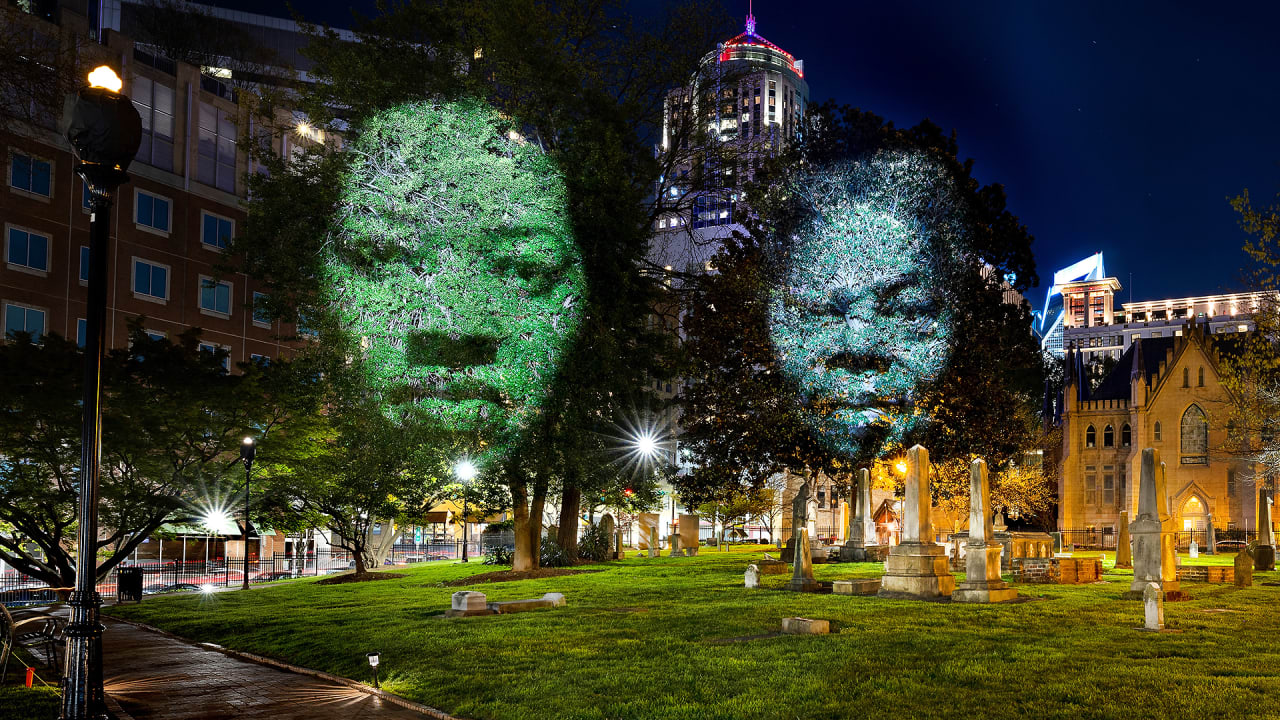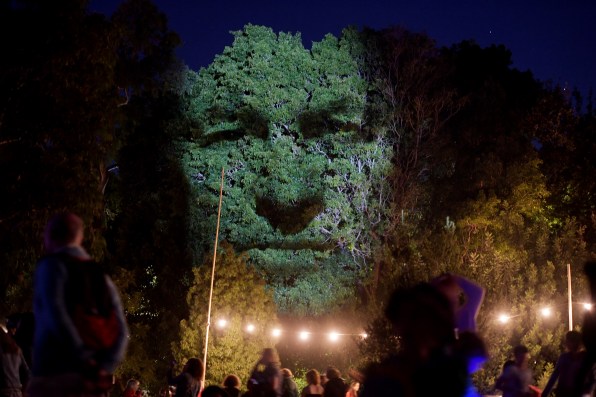
When we think of monuments, we imagine large structures in public spaces that commemorate important individuals: the Lincoln Memorial, Mount Rushmore. But how do we define what makes a person important enough for a monument?
Craig Walsh is obsessed with this question. For the past eight years, the Australian artist has created a series of exhibits called Monuments that play with the idea of who we commemorate, and how. Instead of physical statues, Walsh projects videos of people’s faces onto trees at night, a technique that makes them look like they’re alive and staring down at viewers below.
Walsh chooses to feature individuals who have been historically ignored and overlooked. For instance, the latest iteration of this exhibit, which took place at Shout, an arts and music festival in Charlotte, North Carolina, projected faces of the living descendants of formerly enslaved people onto trees in an old cemetery for Charlotte’s elite. While their enslaved ancestors never had marked graves, this exhibit was meant to honor them and give viewers a sense of what they might have looked like.
For 30 years, Walsh’s art has focused on projecting slides and images onto unconventional surfaces. He first had the idea for the Monuments project in the early ’90s, right after he graduated from his fine arts program at Griffith University in Brisbane. He was at a music festival in the wilderness, driving around in a truck with a slide projector on the back, casting out images onto various natural landscapes. At one point, a black and white image of a face was projected onto a tree. “The tree was in scale with the portrait,” Walsh recalls. “It automatically transformed into a three-dimensional sculpture.”
Eight years ago, Walsh began creating exhibits based on this concept, describing them as “monuments.” “I like the idea of creating temporal monuments through these portraits, ridding ourselves for the need to encompass our vast history in a single object,” he says. “It enables me to look at specific stories around a site.”
Walsh has developed an elaborate process for picking who should be featured in these portraits. He works closely with the community around a particular site to identify the faces that will be projected. At an exhibit at the Brisbane Botanic Gardens, he projected the face of a caretaker who was about to retire. The man had spent decades tending to the plants, but most people didn’t know him. “It was about the everyday individuals who make contributions to the spaces that surround us,” Walsh says. In several exhibits across the country, he worked with indigenous people to project faces of ancestors onto trees. “Over time, any artist refines their practice, recognizing the key issues around the work,” he says. “In the case of Monuments, it is very collaborative work and requires the community to determine who will be featured and what surface to project them onto. It prompts them to have this really important conversation about who they want to have represented in their civic spaces.”
 In Charlotte, he worked with three experts with deep roots in the city: folk artist Nellie Ashford; musician Fannie Mae; and Frederick Murphy, founder of History Before Us, a project that preserves history in film. They each agreed to have their faces filmed for this project as a way to honor their ancestors, all of whom were brought to the United States against their will from Africa.
In Charlotte, he worked with three experts with deep roots in the city: folk artist Nellie Ashford; musician Fannie Mae; and Frederick Murphy, founder of History Before Us, a project that preserves history in film. They each agreed to have their faces filmed for this project as a way to honor their ancestors, all of whom were brought to the United States against their will from Africa.
They decided to project faces onto trees in Old Settlers’ Cemetery, the first burial ground in Charlotte. It operated from 1776 to 1884 and contains the graves of many of the city’s most prominent pioneers. Throughout that period, enslaved people of African descent made up between 14% and 44% of the population. The graves of these people were unmarked. “There were no stones or placards that made reference to them,” says Walsh. “Given the idea of Monuments, we thought this was a very poetic way to make reference to that history.”
Walsh worked to create videos of the three experts’ faces. He takes extended clips of them staring into the camera making very subtle movements, like blinking and swaying ever so slightly. He then picks the trees, and sizes the videos so that the faces take up the entire expanse of the tree’s foliage. He says that creating these projections isn’t particularly challenging from a technological perspective; the complexity has to do with creating and editing videos so they look appropriate on the trees in that particular setting.
There are many ways to interpret these projections, and Walsh likes the diversity of ways in which viewers take them in. Some people simply enjoy how beautiful the projections are: They like how it seems like the art is staring at them, making them the subject of the artwork. It can conjure up the idea that these faces have always been in the background, haunting them. Others see it as a political statement that brings forgotten voices—and faces—back into our collective history, and decolonizes public space. “The work itself also just makes us look at trees,” Walsh says. “That is a good thing, too.”





